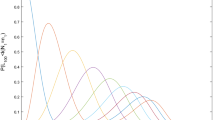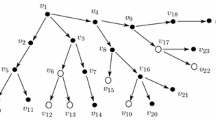Abstract
We propose a continuous-time adaptation of the well-known concept of success runs by considering a marked point process with two types of marks (success-failure) that appear according to an appropriate continuous-time Markov chain. By constructing a bivariate imbedded process (consisting of a run-counting and a phase process), we offer recursive formulas and generating functions for the distribution of the number of runs and the waiting time until the appearance of the n-th success run. We investigate the three most popular counting schemes: (i) overlap** runs of length k, (ii) non-overlap** runs of length k and (iii) runs of length at least k. We also present examples of applications regarding: the total penalty cost in a maintenance reliability system, the number of risky situations in a non-life insurance portfolio and the number of runs of increasing (or decreasing) asset price movements in high-frequency financial data.
Similar content being viewed by others
References
Balakrishnan N, Koutras MV (2002) Runs and scans with applications. Wiley, New York
Binswanger K, Embrechts P (1994) Longest runs in coin tossing. Insur: Math Econ 15:139–149
Boutsikas MV, Koutras MV (2002) Modeling claim exceedances over thresholds. Insurance: Mathematics and Economics 30:67–83
Embrechts P, Kluppelberg C, Mikosch T (2013) Modelling extremal events for insurance and finance. Springer, Berlin
Eryilmaz S (2018) Stochastic ordering among success runs statistics in a sequence of exchangeable binary trials. Methodol Comput Appl Probab 20:563–573
Eryilmaz S, Demir S (2007) Success runs in a sequence of exchangeable binary trials. J Stat Plan Infer 137:2954–2963
Fu JC, Koutras MV (1994) Distribution theory of runs: a Markov chain approach. J Am Stat Assoc 89:1050–1058
Fu JC, Lou WYW (2003) Distribution theory of runs and patterns and its applications: a finite Markov chain imbedding approach. World Scientific
Fu JC, Wu TL, Lou WYW (2012) Continuous, discrete, and conditional scan statistics. J Appl Prob 49:199–209
Glaz J, Naus J, Wallenstein S (2001) Scan statistics. Springer
Koutras MV (2003) Applications of Markov chains to the distribution theory of runs and patterns. Handbook of statistics. Elsevier 21:431–472
Koutras MV, Alexandrou VA (1995) Runs, scans and URN model distributions: A unified Markov chain approach. Ann Inst Stat Math 47:743–766
Makri FS, Psillakis ZM (2011) On success runs of length exceeded a threshold. Methodol Comput Appl Probab 13:269–305
Makri FS, Psillakis ZM (2016) On runs of ones defined on a q-sequence of binary trials. Metrika 79:579– 602
Makri FS, Philippou AN, Psillakis ZM (2007) Success run statistics defined on an urn model. Adv Appl Probab 39:991–1019
Mytalas GC, Zazanis MA (2013) Central limit theorem approximations for the number of runs in Markov-dependent binary sequences. J Statist Plann Inference 143:321–333
Talbot A (1979) The accurate numerical inversion of laplace transforms. IMA J Appl Math 23:97–120
Weideman JAC, Trefethen LN (2007) Parabolic and hyberbolic contours for computing the Bromwich integral. Math Comput 76:1341–1356
Wu T-L, Glaz J (2015) A new adaptive procedure for multiple window scan statistics. Comput Stat Data Anal 82:164–172
Author information
Authors and Affiliations
Corresponding author
Additional information
Publisher’s Note
Springer Nature remains neutral with regard to jurisdictional claims in published maps and institutional affiliations.
Rights and permissions
About this article
Cite this article
Michael, B.V., Eutichia, V. On the Distribution of the Number of Success Runs in a Continuous Time Markov Chain. Methodol Comput Appl Probab 22, 969–993 (2020). https://doi.org/10.1007/s11009-019-09743-3
Received:
Revised:
Accepted:
Published:
Issue Date:
DOI: https://doi.org/10.1007/s11009-019-09743-3
Keywords
- Run statistics
- Marked point process
- Continuous-time Markov chain
- Waiting time
- Exact distribution
- Markov chain imbedding technique
- Generating function
- Laplace transform




